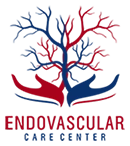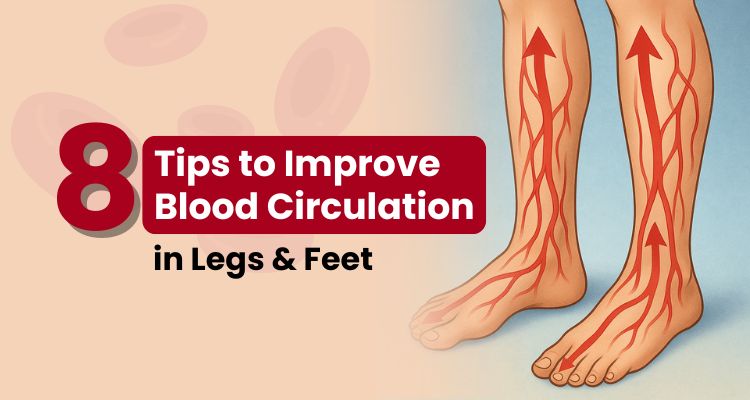Tingling, swelling, or throbbing pain in your feet or legs usually indicates poor blood circulation. It interferes with the quality of oxygen and nutrients delivered to muscles and tissues, decreasing comfort and mobility. Most people ignore early signs, which subsequently might result in varicose veins, heaviness, or mild aching, which are the common varicose veins early stages symptoms.
Medical consultation still is essential, but knowing how improve circulation in legs can make a great difference. Regular movement, a balanced diet, and proper leg maintenance can naturally enhance blood flow. Let’s find out eight easy and effective tips to enhance circulation in your legs and feet and keep them healthy daily.
Why Is Blood Circulation So Important?
Healthy blood flow keeps your body running smoothly and enables you to maintain a better quality of life. Restricted circulation can bring on leg pain that causes walking or even everyday movement to become a problem.
Insufficient blood supply is typically linked to diseases like peripheral artery disease (PAD) and chronic venous insufficiency (CVI), where the blood is not able to flow back to the heart. Such disorders cause the development of swelling, numbness, and discolouration of the legs. Proper circulation is a source of vitality and overall well-being.
Tips for Improving Blood Circulation in Legs and Feet
Below are some ways that guide you to know how to improve foot blood circulation easily.
1. Begin Your Day with Stretching
One of the good things that you can do for your body is to stretch. It sure doesn’t have to be wild or long. Simply getting up from bed and stretching for a few minutes is a neat way to relax your muscles and invite blood flow to your whole body for the rest of the day.
Only a few minutes of stretching can be quite adequate for banishing stiffness and, simultaneously, enhancing leg flexibility when done either before or after getting out of bed. Consistent stretching also keeps you free from cramps and allows better oxygen intake of your tissues, thus your body becomes more energised and stable.
2. Exercise Regularly
Exercise also has a major role in enhancing circulation and making the vascular system stronger. Even low-impact or light exercise for blood circulation in leg, such as walking or pool exercises, can improve blood flow and maintain healthy arteries.
Basically, your blood vessels are forced to dilate and carry oxygen more efficiently through repeated movement. Anybody with joint or back pain can best undertake low-impact activities like cycling, yoga, or swimming. Regular exercise also works the leg muscles, thus veins are assisted in pumping blood back to the heart, and the occurrence of swelling or heaviness is lessened.
3. Go for a Walk Every Day
Besides, walking is still one of the least complicated and most efficient methods to increase blood circulation in the legs. A walk of 1 or 2 kilometres every day has the function of making vessels, which are small branches of the blood vessels called collaterals, healthier, and thus the oxygen supply to the leg muscles is improved.
It’s more beneficial to walk on level ground as this lessens the straining of your joints and knees. People who are not capable of walking outside may walk on a treadmill indoors. Frequent and continuous walking is a good way to keep one’s blood circulation in feet and to build up the legs over time.
4. Wear Compression Socks
Compression stockings give your legs a gentle pressure that assists veins in pushing blood back to the heart. They prevent blood from pooling in the lower legs and thus alleviate swelling or heaviness. Choosing the right size is very important both for comfort and for the effectiveness of the stockings.
If you wear compression stockings on a long flight, during a long car journey or if you are standing for a long time, they can be of great help. Besides that, compression stockings can be worn as a supportive accessory during exercise or by those who have circulation problems or suffer from venous issues, making them a handy component of the varicose veins treatment in Mumbai.
5. Quit Smoking and Limit Alcohol
Smoking causes damage to blood vessels and makes them less elastic, which limits the flow of blood. Alcohol, if it is consumed in large quantities, is also bad for circulation. One of the best ways to keep your blood vessels healthy is to stop smoking. Nicotine replacement therapy, support groups, and professional help are different ways that you may make quitting easier.
Keeping alcohol intake moderate maintains optimal blood pressure and normal arteries. Giving up these activities brings enhanced delivery of oxygen and minimises the risk of circulatory disorders, helping you understand how to increase leg blood circulation naturally and effectively.
6. Keep Your Legs Elevated
Lifting your legs above the level of your hips allows gravity to help push blood back towards your heart. These are absolutely amazing for anyone suffering from venous insufficiency or edema in the legs. It is quite common to perform leg circulation exercises, and afterwards, to raise the legs for a more even circulation.
Helping the legs with a pillow, stool, or any soft thing under them while resting or sitting relieves the pain and also prevents the blood from pooling. Frequent elevation of legs and short breaks once in a while during the day help the blood circulation in legs and feet and bring relaxation.
7. Make Healthy Dietary Changes
Good nutrition is not only good for your heart but also your vessels. Being overweight impairs the veins because fat weighs on the vessels, and the blood cannot flow as easily as before. Salt reduction is a way to eliminate heaviness and oedema. Adopting a Mediterranean diet consisting of whole grains, lean meat, vegetables, and healthy fats will help keep your arteries clean and avoid the development of such diseases as atherosclerosis.
Not eating red meat and full-fat dairy products is one of the best ways to lower cholesterol. On the other hand, drinking sufficient water and consuming foods rich in fibre will help keep your blood circulation healthy and regular, which is indirectly a simple answer to how to improve circulation in feet naturally.
8. Maintain a Consistent Routine
How blood flows through the vessels can be very different depending on whether the person is moving, eating, or drinking in the same way or not. All the veins and arteries in your body will remain healthy if you do some regular exercise for blood circulation, eat a balanced diet and get proper rest.
If you keep yourself busy throughout the day and don’t sit or stand for a long period, you will be able to prevent the occurrence of stiffness and swelling. The long-term results will be more productive if you combine exercising with leg elevation and eating properly. By making these simple habits, you will improve your circulation in a natural way, and your legs will feel light and energised.
When to See a Doctor
Certain symptoms of poor circulation can indicate an underlying serious medical issue. If you experience:
- Persistent or frequent leg cramps and pain
- Unhealing wounds or ulcers on the feet
- Sudden or significant swelling in one or both legs
- Coldness, discolouration, or numbness in your toes or legs
- Recurring tingling or weakness that interferes with movement
Final Words
The reason why your legs are strong, active and pain-free is healthy blood circulation. Carrying out the above lifestyle habits, such as going for a walk, stretching, taking a well-balanced diet, and raising your legs, will not only enhance the blood flow but also reduce the chances of getting complications. Basically, it is a case of severe vascular problems, such as varicose veins, DVT, or PAD, that call for the intervention of a doctor.Among the minimally invasive surgical options, the leading Interventional Radiologist in Mumbai, Dr. Kunal Arora, would be the most suitable choice to carry out the treatments aimed at blood flow restoration and thereby improve patients’ well-being. Book your appointment today and experience the best care with expert consultation and the personal touch of Dr. Kunal Arora, a trusted name in vascular and interventional radiology.


